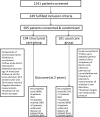Effects of structured versus usual care on renal endpoint in type 2 diabetes: the SURE study: a randomized multicenter translational study
- PMID: 19460913
- PMCID: PMC2681013
- DOI: 10.2337/dc08-1908
Effects of structured versus usual care on renal endpoint in type 2 diabetes: the SURE study: a randomized multicenter translational study
Abstract
Objective: Multifaceted care has been shown to reduce mortality and complications in type 2 diabetes. We hypothesized that structured care would reduce renal complications in type 2 diabetes.
Research design and methods: A total of 205 Chinese type 2 diabetic patients from nine public hospitals who had plasma creatinine levels of 150-350 micromol/l were randomly assigned to receive structured care (n = 104) or usual care (n = 101) for 2 years. The structured care group was managed according to a prespecified protocol with the following treatment goals: blood pressure <130/80 mmHg, A1C <7%, LDL cholesterol <2.6 mmol/l, triglyceride <2 mmol/l, and persistent treatment with renin-angiotensin blockers. The primary end point was death and/or renal end point (creatinine >500 micromol/l or dialysis).
Results: Of these 205 patients (mean +/- SD age 65 +/- 7.2 years; disease duration 14 +/- 7.9 years), the structured care group achieved better control than the usual care group (diastolic blood pressure 68 +/- 12 vs. 71 +/- 12 mmHg, respectively, P = 0.02; A1C 7.3 +/- 1.3 vs. 8.0 +/- 1.6%, P < 0.01). After adjustment for age, sex, and study sites, the structured care (23.1%, n = 24) and usual care (23.8%, n = 24; NS) groups had similar end points, but more patients in the structured care group attained >or=3 treatment goals (61%, n = 63, vs. 28%, n = 28; P < 0.001). Patients who attained >or=3 treatment targets (n = 91) had reduced risk of the primary end point (14 vs. 34; relative risk 0.43 [95% CI 0.21-0.86] compared with that of those who attained <or=2 targets (n = 114).
Conclusions: Attainment of multiple treatment targets reduced the renal end point and death in type 2 diabetes. In addition to protocol, audits and feedback are needed to improve outcomes.
Trial registration: ClinicalTrials.gov NCT00309127.
Figures


Comment in
-
Intensive diabetes management for high-risk patients: how best to deliver?Diabetes Care. 2009 Jun;32(6):1132-3. doi: 10.2337/dc09-0540. Diabetes Care. 2009. PMID: 19460918 Free PMC article. No abstract available.
Similar articles
-
Effects of structured care by a pharmacist-diabetes specialist team in patients with type 2 diabetic nephropathy.Am J Med. 2005 Dec;118(12):1414. doi: 10.1016/j.amjmed.2005.07.050. Am J Med. 2005. PMID: 16378791 Clinical Trial.
-
Efficacy of intensive multitherapy for patients with type 2 diabetes mellitus: a randomized controlled trial.CMAJ. 2005 Dec 6;173(12):1457-66. doi: 10.1503/cmaj.050054. Epub 2005 Nov 17. CMAJ. 2005. PMID: 16293781 Free PMC article. Clinical Trial.
-
Role of intensive glucose control in development of renal end points in type 2 diabetes mellitus: systematic review and meta-analysis intensive glucose control in type 2 diabetes.Arch Intern Med. 2012 May 28;172(10):761-9. doi: 10.1001/archinternmed.2011.2230. Arch Intern Med. 2012. PMID: 22636820 Free PMC article. Review.
-
Analysis of metabolic parameters as predictors of risk in the RENAAL study.Diabetes Care. 2003 May;26(5):1402-7. doi: 10.2337/diacare.26.5.1402. Diabetes Care. 2003. PMID: 12716796
-
What matters in ADVANCE and ADVANCE-ON.Diabetes Obes Metab. 2012 Jan;14 Suppl 1:20-9. doi: 10.1111/j.1463-1326.2011.01509.x. Diabetes Obes Metab. 2012. PMID: 22118707 Review.
Cited by
-
Effect of a Web-Based Management Guide on Risk Factors in Patients With Type 2 Diabetes and Diabetic Kidney Disease: A JADE Randomized Clinical Trial.JAMA Netw Open. 2022 Mar 1;5(3):e223862. doi: 10.1001/jamanetworkopen.2022.3862. JAMA Netw Open. 2022. PMID: 35333363 Free PMC article. Clinical Trial.
-
Intensive glycaemic control for patients with type 2 diabetes: systematic review with meta-analysis and trial sequential analysis of randomised clinical trials.BMJ. 2011 Nov 24;343:d6898. doi: 10.1136/bmj.d6898. BMJ. 2011. PMID: 22115901 Free PMC article. Review.
-
Evolution of Diabetes Care in Hong Kong: From the Hong Kong Diabetes Register to JADE-PEARL Program to RAMP and PEP Program.Endocrinol Metab (Seoul). 2018 Mar;33(1):17-32. doi: 10.3803/EnM.2018.33.1.17. Endocrinol Metab (Seoul). 2018. PMID: 29589385 Free PMC article. Review.
-
Young-Onset Diabetes in East Asians: From Epidemiology to Precision Medicine.Endocrinol Metab (Seoul). 2024 Apr;39(2):239-254. doi: 10.3803/EnM.2024.1968. Epub 2024 Apr 16. Endocrinol Metab (Seoul). 2024. PMID: 38626908 Free PMC article. Review.
-
Inpatient multidisciplinary care can prevent deterioration of renal function in patients with chronic kidney disease: a nationwide cohort study.Front Endocrinol (Lausanne). 2023 Jun 20;14:1180477. doi: 10.3389/fendo.2023.1180477. eCollection 2023. Front Endocrinol (Lausanne). 2023. PMID: 37409235 Free PMC article.
References
-
- Gaede P, Lund-Andersen H, Parving HH, et al. : Effect of a multifactorial intervention on mortality in type 2 diabetes. N Engl J Med 2008; 358: 580– 591 - PubMed
-
- Gaede P, Vedel P, Larsen N, et al. : Multifactorial intervention and cardiovascular disease in patients with type 2 diabetes. N Engl J Med 2003; 348: 383– 393 - PubMed
-
- So WY, Kong AP, Ma RC, et al. : Glomerular filtration rate, cardiorenal end points, and all-cause mortality in type 2 diabetic patients. Diabetes Care 2006; 29: 2046– 2052 - PubMed
-
- Ritz E, Rychlik I, Locatelli F, et al. : End-stage renal failure in type 2 diabetes: a medical catastrophe of worldwide dimensions. Am J Kidney Dis 1999; 34: 795– 808 - PubMed
-
- So WY, Tong PC, Ko GT, et al. : Effects of protocol-driven care versus usual outpatient clinic care on survival rates in patients with type 2 diabetes. Am J Manag Care 2003; 9: 606– 615 - PubMed
Publication types
MeSH terms
Substances
Associated data
LinkOut - more resources
Full Text Sources
Medical
Miscellaneous

